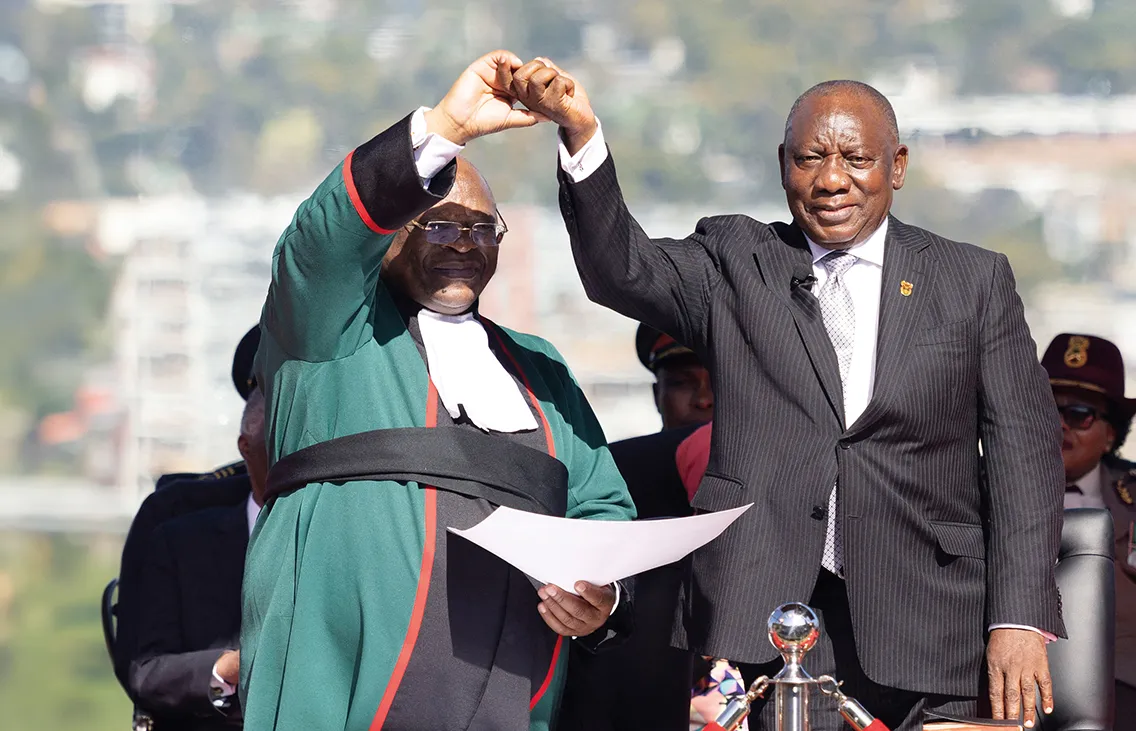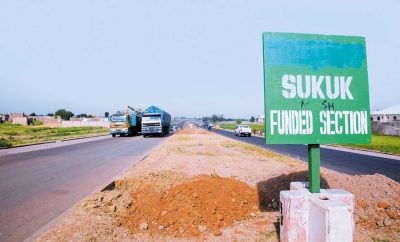
The lack of an outright winner in May’s South African elections could have heralded a period of political and economic instability. Yet the unexpected alliance between the African National Congress (ANC) and Democratic Alliance (DA) has got off to a good start and there is cautious optimism that an economic improvement is at least a possibility. This will hearten the country’s banks, which have performed remarkably well in the face of low growth over many years.
May’s election saw the ANC lose its sole grip on power for the first time since 1994, largely as a result of its failure to improve living standards over many years. President Cyril Ramaphosa opted for what was clearly the best – but politically difficult – option, in creating a coalition government with the DA, Inkatha Freedom Party and Patriotic Alliance.
The centre-right DA’s inclusion is particularly noteworthy as the party is generally considered more pro-business and is expected to steer government policy away from rigid state control in several areas. Two parties more hostile to the private sector, uMkhonto weSizwe and the Economic Freedom Fighters, did not join the new government.
Slightly more market-friendly policies are expected to be introduced but this is not only the result of the DA’s influence. The ANC has always comprised disparate interests but the party was already slowly pivoting towards weakening some state monopolies and allowing a greater role for the private sector before the election – a process that is now likely to accelerate with the DA on board.
It is likely that the DA’s inclusion and possession of six out of 32 cabinet posts will speed up structural reforms, including the government’s Operation Vulindlela to deregulate some sectors.
There will be ongoing disagreements over black economic empowerment, the level of welfare payments and foreign policy, but much will depend on whether the new alliance exposes divisions within the ANC. Some activists in the party and more left-wing parties have accused Ramaphosa of ‘selling out’ by allying with John Steenhuisen’s DA, which many view as representing the interests of White South Africans.
Private sector operators are sought for some state-owned infrastructure, although some in the ANC refuse to accept that offering 25-year concessions is any different to outright privatisation.
Ultimately, the impact of the new coalition will be greater on the economy in general than on the banking industry in particular. The economy has stagnated over many years, achieving average annual growth of just 0.8% over the past 12 years, resulting in an unemployment rate of 33.5% in the second quarter of 2024.
This has had an impact on South African banks in terms of the revenues they have been able to generate, forcing them to look more to the rest of the continent for growth. The country’s biggest bank, Standard Bank, has been particularly active in expanding across the continent and now operates in 20 African countries.
The markets generally welcomed the new coalition when it was unveiled, with the Johannesburg Stock Exchange (JSE) and rand both strengthening when the new government was announced. The rand gained more than 5% against the US dollar between the May election and mid-October, while the JSE rose 20% over the same period.
It is too soon for the new government to have had any real impact but it will be slightly buoyed by the 0.4% growth recorded in the second quarter as power supplies improved a little and consumer spending jumped.
Some analysts forecast more rapid growth from the fourth quarter of this year onwards because of an anticipated fall in interest rates that could continue into next year.
At the same time, pension reforms should allow investors to withdraw some of their pension pot prior to retirement from September onwards. The South African Reserve Bank (SARB) forecasts that R40-100bn ($2.2-5.6bn) could be withdrawn by the end of this year, driving up consumer spending in the process.
Speaking to the UN General Assembly in September, Ramaphosa was very upbeat, forecasting 3% growth next year and describing the new Government of National Unity as his country’s “second miracle”, with the collapse of Apartheid regarded as the first.
An improved macro-economic picture would help the SARB cut interest rates, which in turn should reduce the level of bad bank debts. The current prime lending rate is 11.5%, with a repo rate of 8.25%, lower than in many African countries but high by international standards. South African banks could also benefit from growing international confidence in the government because they hold large amounts of government debt.
Ramaphosa has pledged to tackle economic injustice in what is one of the most economically unequal countries in the world but previous ANC promises to the same effect have had little impact. It will also be difficult to achieve alongside a promise to rein in the national debt.
Over the past decade, the ANC has sought to curtail public spending in order to increase confidence in the national economy but while this hit public services, it did little to kickstart economic growth.
Infrastructural demands
There are two areas in particular where the government can make a big difference to the economy and therefore also to the banking sector: ensuring much greater investment in key infrastructure, particularly in the power and transport sectors. Electricity rationing has become a big feature of South African life as power utility Eskom has struggled to produce enough electricity.
Competition in power generation is increasing as a result of private sector investment in solar and wind power projects but Pretoria needs to push ahead with unbundling the parastatal to create separate generation, transmission and distribution companies. The new transmission operator must invest in building the new grid capacity needed to connect new solar and wind farms, while more independent power producers are needed to boost total capacity.
At the same time, years of underinvestment have seen the rail network deteriorate and too little new capacity added to the country’s port terminals. Congestion has become a big problem, including at the Port of Durban, where new container capacity is needed to support future economic growth.
Once these huge infrastructural shortcomings have been corrected, South Africa can begin to attract much greater investment in the manufacturing sector.
South African banks have helped the automotive industry steadily grow and there is scope for them to do the same with other forms of manufacturing providing factories can benefit from guaranteed power supplies and the ability to move components and finished products quickly and reliably.
They can also benefit from financing new investment projects, including a pipeline of renewable energy projects measuring 22.5GW, a huge amount in comparison with installed generating capacity of 54.7GW.
Pretoria must also face falling investment in the mining sector, traditionally a big area of lending for South African banks. Improving port and rail infrastructure will go a long way to addressing that, as will tackling persistent criminal attacks on the main heavy-haul rail lines, although transport utility Transnet is working with the police and mining companies to improve track security and mount joint patrols.
While coal production and exports have fallen in recent years, and the iron ore sector has been hit more recently, the country’s manganese production is increasing and rapidly rising global demand for critical minerals is likely to generate more demand for financing from South African banks, with or without government support.
Banking sector performance
The South African banking sector has generally outperformed the economy as a whole in recent years and recorded 2.5% growth in combined headline earnings in the first half of this year in comparison with the same period last year. However, these results continue to be buoyed by bank operations on the rest of the continent.
The rand’s recovery also increased bank foreign currency reserves, although high inflation levels drove cost-to-income and credit loss ratios higher. FirstRand Bank, for instance, recorded an increase in its credit loss ratio from 74 basis points (bps) in the second half of 2022 to 83 bps for the same period last year.
The industry is also in the midst of a period of digital transformation. According to consultants PwC, the number of customers using digital banking platforms has now broken the 20m barrier for the first time, with both established banks and digital-first banks investing heavily in new platforms. “While prospects for the rest of 2024 remain complex and uncertain, consensus expectations for interest rate cuts across several territories provide a basis for optimism”, reported PwC.
Despite cautious optimism over the new government, the banking sector continues to face a wide number of challenges. “Lending growth, which decelerated in 2023, will remain muted in 2024, in mid-single digits. This is due to the slow improvement in domestic demand and private consumption amid the still-unreliable electricity supply, weak disposable income growth, and still-high market rates, constraining loan affordability for households,” said credit ratings agency Fitch in a report earlier this year.
There seems a genuine desire among the ANC and DA to make their unlikely alliance work because of the dire state of the country’s economy. There are plenty of areas of disagreement that could see the government collapse before the next election in five years’ time but the initial signs are promising. South African banks will benefit if the economy finally begins to grow more significantly but it would be no surprise to see the country’s biggest banks continue to expand their operations across the rest of the continent.
Want to continue reading? Subscribe today.
You've read all your free articles for this month! Subscribe now to enjoy full access to our content.
Digital Monthly
£8.00 / month
Receive full unlimited access to our articles, opinions, podcasts and more.
Digital Yearly
£70.00 / year
Our best value offer - save £26 and gain access to all of our digital content for an entire year!

 Sign in with Google
Sign in with Google 



